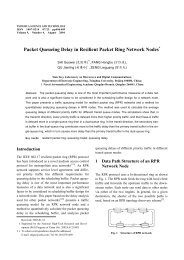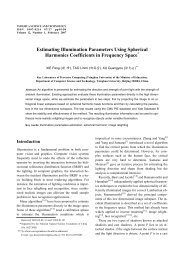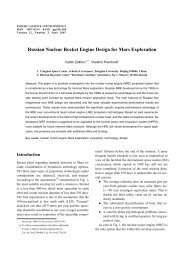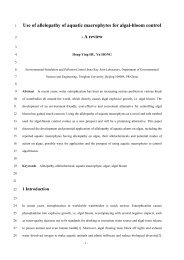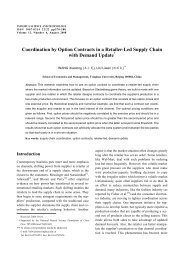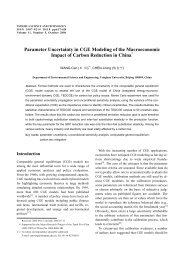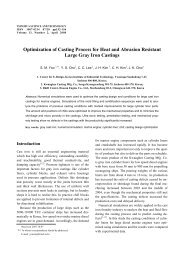Information Sharing in a Multi-Echelon Inventory System
Information Sharing in a Multi-Echelon Inventory System
Information Sharing in a Multi-Echelon Inventory System
You also want an ePaper? Increase the reach of your titles
YUMPU automatically turns print PDFs into web optimized ePapers that Google loves.
470<br />
{ ( ) }<br />
P x′ 1| x1, a1 x1<br />
=<br />
a1<br />
⎧<br />
⎪∑<br />
P{ D= x1 + b− x′ 1} m( a1, b), ⎪b<br />
= 0<br />
⎨ a1<br />
⎪<br />
P{ D x1 + b} m( a1, b) ,<br />
⎪∑<br />
≥<br />
⎩b<br />
= 0<br />
if x′<br />
1 > 0;<br />
if x′<br />
1 = 0<br />
(22)<br />
With a given order-delivery rate matrix M, { x , a ( x ) }<br />
1 1 1<br />
is a DTMDP.<br />
The retailer’s policy ϕ 1 = { a1(0) , a1(1) , , a1( U1)<br />
} is<br />
obta<strong>in</strong>ed by solv<strong>in</strong>g the DTMDP to m<strong>in</strong>imize the ex-<br />
ϕ1<br />
ϕ1<br />
pected long-run average cost. Denote Φ 1 = { π 1 (0) ,<br />
ϕ1 ϕ1<br />
π1 (1) , , π1<br />
( U1)}<br />
as the stationary distribution for policy<br />
ϕ 1 . Furthermore, denote the order distribution of the<br />
retailer for policy ϕ 1 by O1 = { o1(0) , o1(1) , , o1( U1)<br />
} .<br />
The order distribution can be calculated from<br />
1( ) =<br />
U1<br />
k = 0<br />
ϕ1 π1<br />
( ) ⋅ 1 { ϕ1<br />
1 ( ) = } , = 01 , , , 1<br />
o j ∑ k a k j j U (23)<br />
In the system, the retailer’s order distribution is<br />
known to the supplier. With the retailer’s order distribution,<br />
the one-step transition probability for the supplier<br />
from state 0 x to state x′ 0 with action<br />
a ( x ) ∈ A ( x ) is given by<br />
0 0 0 0<br />
U<br />
1<br />
+<br />
{ ′ } ∑ { ′<br />
}<br />
P x | x , a ( x ) = 1 x = ( x + a ( x ) − z) ⋅o<br />
( z)<br />
0 0 0 0 0 0 0 0 1<br />
z=<br />
0<br />
With a given retailer’s order distribution<br />
(24)<br />
1 , O<br />
{ x0 a0( x0)<br />
}<br />
icy ϕ = { a (0) , a (1) , , a ( U ) }<br />
, is a DTMDP. The supplier’s order<strong>in</strong>g pol-<br />
and the stationary<br />
0 0 0 0 0<br />
ϕ0 Φ0 =<br />
ϕ0 π0 ϕ0 , π0 ϕ0<br />
, , π0<br />
U0<br />
state distribution { (0) (1) ( ) }<br />
for this policy are obta<strong>in</strong>ed by solv<strong>in</strong>g the DTMDP.<br />
The order-delivery rate matrix is then updated as<br />
⎡ m′<br />
(0, 0)<br />
⎤<br />
⎢<br />
m′ (1, 0) m′<br />
(1, 1)<br />
⎥<br />
M ′ = ⎢ ⎥<br />
⎢ ⎥<br />
⎢ ⎥<br />
⎣m′ ( U1, 0) m′ ( U1, 1) m′ ( U1, U1)<br />
⎦ (25)<br />
where<br />
m′ ( a , b)<br />
=<br />
1<br />
U0<br />
ϕ0 ϕ1<br />
1{ b m<strong>in</strong> a1 x0 a0 ( x0) } π 0( x0) o1 ( a1)<br />
x0<br />
0<br />
∗<br />
∑ = ⎡<br />
⎣ , + ⎤<br />
⎦ ⋅ ⋅ (26)<br />
=<br />
that satisfies<br />
a1<br />
∑<br />
0 ≤m′ ( a , b) ≤ 1 , m′ ( a , b)<br />
= 1.<br />
1 1<br />
b=<br />
0<br />
Ts<strong>in</strong>ghua Science and Technology, August 2007, 12(4): 466-474<br />
If the system reaches equilibrium, then for<br />
all a1 = 01 ,, , U1,<br />
b= 01 ,, , a1,<br />
m′ ( a1, b) = m( a1, b)<br />
,<br />
i.e., M = M ′ . Therefore, an iterative algorithm can be<br />
developed to search for the equilibrium order-delivery<br />
rate matrix which will then give the equilibrium policy<br />
ϕ , ϕ .<br />
{ }<br />
0 1<br />
Algorithm 2<br />
Step 1: Set <strong>in</strong>itial values of M and ε .<br />
Step 2: Solve the retailer’s DTMDP to obta<strong>in</strong> the op-<br />
ϕ1<br />
timal policy ϕ 1 , the stationary distribution Φ and<br />
the order distribution O1 of the retailer.<br />
Step 3: Solve the supplier’s DTMDP to obta<strong>in</strong> the<br />
optimal policy ϕ 0 and the stationary distribution<br />
ϕ0<br />
Φ of the supplier.<br />
Step 4: Update the order-delivery rate matrix M ′<br />
accord<strong>in</strong>g to Eq. (26).<br />
Step 5: If ∆( M − M ′ ) < ε , stop; otherwise let M ′<br />
be the new order-delivery rate matrix and return to<br />
Step 2.<br />
In Step 5, ∆( M − M′ ) =|| M − M ′ || , where || X ||<br />
max x − m<strong>in</strong> x .<br />
is the norm with { ij} { ij}<br />
i, j<br />
i, j<br />
3.3 Supplier-dom<strong>in</strong>ated <strong>in</strong>formation shar<strong>in</strong>g<br />
In this case, the supplier knows the retailer’s state at<br />
each decision epoch, but the retailer only knows its<br />
own state. Assume that the supplier also knows the<br />
consumer demands to the retailer. The retailer’s state<br />
space and action space are<br />
S = 012 ,, , , U<br />
(27)<br />
{ }<br />
1 1<br />
{ }<br />
A ( x ) = 01 , , 2,<br />
, U −x<br />
(28)<br />
1 1 1 1<br />
As mentioned <strong>in</strong> Section 3.2, the retailer policy can<br />
be obta<strong>in</strong>ed from the order-delivery rate matrix if the<br />
retailer only knows its own state. Hence, the solution is<br />
similar to that <strong>in</strong> Section 3.2. However, s<strong>in</strong>ce the supplier<br />
knows the retailer’s state, the probability that the<br />
retailer orders a1( x 1)<br />
at state x 1 and receives b <strong>in</strong><br />
the next period depends on the retailer’s current state<br />
x 1 . Therefore, the relationship between the order and<br />
the delivery to the retailer can be described with a vec-<br />
<br />
tor of matrices M = ⎡<br />
⎣<br />
M ⎤ x , x<br />
1 ⎦ 1∈S1, where



